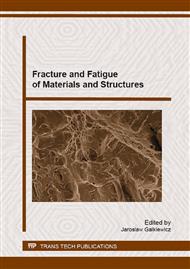p.197
p.203
p.209
p.217
p.223
p.232
p.238
p.244
p.250
Influence of Metal Foil on Interface Stress State in CFRP Laminate
Abstract:
Various materials of high specific stiffness and strength are used in aircraft structures, therefore, methods of joining them are continually improved. Adhesive joining is the most popular method used in composite structures, however, mechanical joining is often necessary due to constructional reasons. Stress concentration around the hole (notch) and point load (fastener action) transfer into the structure are the main disadvantages of mechanical joints, especially, in composite structures. The bearing failure is the only global progressive mechanism of mechanically fastened laminates and therefore it is the acceptable one. Different attempts to improve bearing performance of laminates have been considered by many authors. One of the most interesting solutions is bonding the titanium foils (thin inserts) into the composite structure. The aim of the paper is analysis of a metal insert influence on the stress state around the hole. Specimens made of carbon fibre reinforced plastic and locally modified laminate (part of prepreg layer around the hole is replaced with a circular titanium foil) have been taken into account. The specimens were manufactured in a co-curing process using autoclave technology. Nonlinear analyses were carried out with Marc code. In a locally modified laminate, the main mechanism of load transfer is interlaminar shear stress. The area of load transfer is augmented by the area of metal-fibre adhesive joining. A significant part of the applied load is carried by titanium foils, then it is gradually transferred by means of shear stresses due to adhesion between titanium foils and laminate layers. Bearing performance depends on the insert material stiffness and its elasto-plastic behaviour. Bearing stiffness reduction is strongly influenced by parameters of the titanium-laminate adhesive interface.
Info:
Periodical:
Pages:
223-231
Citation:
Online since:
April 2016
Keywords:
Price:
Сopyright:
© 2016 Trans Tech Publications Ltd. All Rights Reserved
Share:
Citation:


